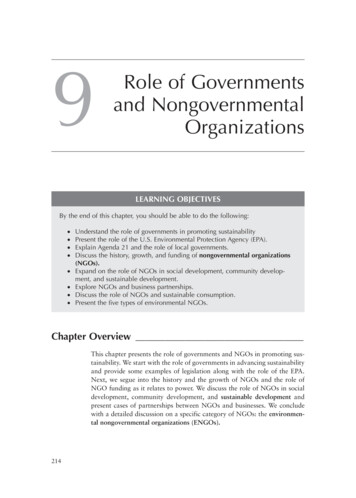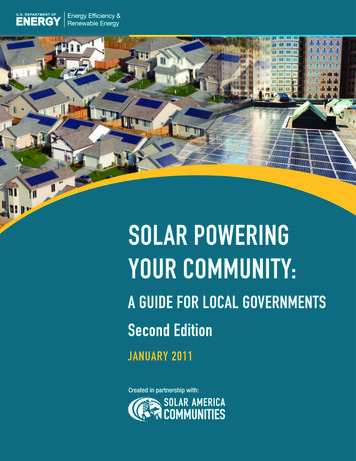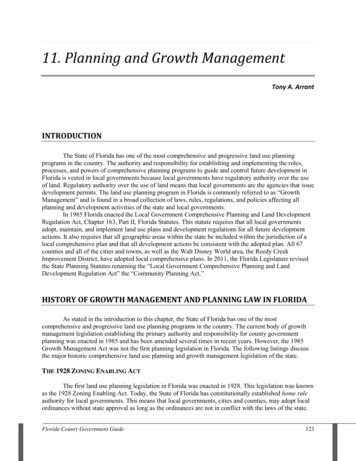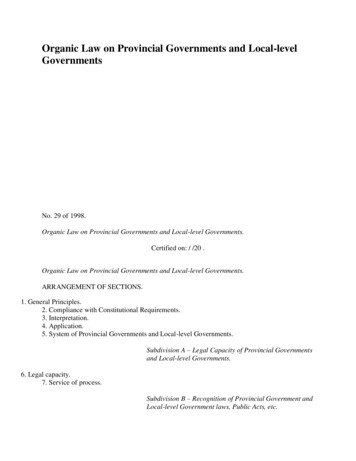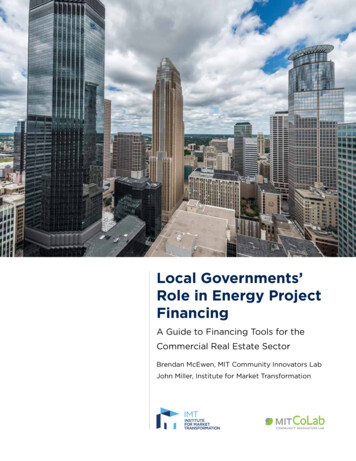
Transcription
Local Governments’Role in Energy ProjectFinancingA Guide to Financing Tools for theCommercial Real Estate SectorBrendan McEwen, MIT Community Innovators LabJohn Miller, Institute for Market Transformation
Acknowledgements: We would like to acknowledge NRDC’s PhilipHenderson and the following IMT staff: Robert Sahadi, Andrea Levin andLeonard Kolstad.About IMT: The Institute for Market Transformation (IMT) is a Wash-ington, DC-based nonprofit organization dedicated to promoting energyefficiency, green building, and environmental protection in the UnitedStates and abroad. Much of IMT’s work addresses market failures thatinhibit investment in energy efficiency. For more information, visit imt.org.About CoLab: The Community Innovators Lab (CoLab) is a center forplanning and development within the MIT Department of Urban Studiesand Planning (DUSP). CoLab’s Green Economic Development Initiative(GEDI) supports economic development organizations pursuing the triplebottom line priorities of environmental sustainability, social justice andeconomic opportunity.For Further Information Contact:IMTJohn MillerProgram Manager, Energy Efficiency Finance Policy1707 L St. NWSuite 1050Washington, DC 20036finance@imt.orgCover Image: Minneapolis, MN, provides loans for energy improvementsto local businesses. See page 23 for additional details.Design by Sensical Design & CommunicationCover photo by Shutterstock/IVY PHOTOS
OverviewDRIVEN BY A NEED TO FOSTER ECONOMICdevelopment, create jobs, and addressenvironmental concerns, cities are increasinglyrecognizing the need to encourage investmentin building performance with creativeContentsfinancing mechanisms. Making the largest1. The Need for Energyimpact possible with limited funds can beProject Financing 42. Market-Based Energychallenging. However, cities now have anEfficiency Finance Tools 10abundance of governmental and private sector3. Financing Options fortools available to finance these investments.In every city, there are market leaders—institutions or property owners able to accessconventional finance or “self-fund” to meetefficiency goals—as well as various otherproperty owners with a more pressing need forfinancial assistance. This guide aims to helpcities weigh various energy efficiency financestrategies and choose policies best tailored tothe individual needs of each local market.Local Government 204. Summary of FinancingMechanisms 365. Works Cited 41
1The Need for Energy Project FinancingREALIZING THE FULL ECONOMIC AND ENVIRONMENTAL BENEFITSof building energy upgrades will require innovative project financingmechanisms deployed on large scales. While not every project requiresthird party financing (some owners can pay for upgrades via their own cashreserves), new financing mechanisms are the key to enabling many ownersto pursue more comprehensive projects.Local governments have an important role to play in supportingemerging markets for energy upgrade financing. This guide is intended tohelp local governments navigate financing options, as they work to assistcommercial and multifamily buildings pursuing deeper energy upgradeopportunities. This guide: Describes the types of challenges that exist for financing energy upgradeprojects—it notes important financing gaps in the commercial energyupgrade market. It also notes principles that local governments shouldconsider as they seek to improve the availability of upgrade financing. Describes various upgrade financing mechanisms. Chapter 2 reviewsmore “market based” tools; local governments can support the use ofsuch tools via education, credit enhancements, and partial funding.Chapter 3 describes mechanisms that generally require more activegovernment support.What do we mean by “Energy Upgrade”?We use “energy upgrades” to refer to any building improvement requiring capital funding thatimproves the energy performance of the building—this could include energy efficiency measures,integration of renewable energy generation, technologies to implement demand response and connections to energy infrastructure such as microgrids and district energy. We do not seek to covermechanisms to finance district-scale energy infrastructure (microgrids and district energy systems;“virtual microgrids”; etc.); a variety of other financing mechanisms can be used to implement suchdistrict infrastructure.Increasingly, energy upgrades are being coupled with ongoing energy management services thatprovide continuous operational improvements. Many energy service providers will roll the costsof management of buildings’ energy systems into upgrade financing repayments. This documentdoes not seek to describe the various third-party energy management service structures that mayaccompany upgrade project financing.4 Institute for Market Transformation www.imt.org
The Need for Energy Project FinancingExtent of Investment Needed to Achieve All CostEffective Energy Management OpportunitiesNumerous studies have noted the tremendous potential for energy efficiency in existing US commercial buildings, and the broader US economy.Estimates by Deutsche Bank Climate Change Advisors and the RockefellerGroup suggest that roughly 72 billion will need to be deployed to achieveall profitable efficiency in existing buildings.This investment requirement dwarfs current spending on energy efficiency—Rockefeller and Deutsche Bank estimate that in 2012, roughly 1.5billion was spent in dedicated project financing for commercial buildingenergy retrofits with turnkey project management by a service provider (RF& DBCCA, 2012).Moreover, many projects only pursue energy management measureswith relatively short “pay back periods”; many building owners note thatthey will only consider energy management measures with a 2-3 year payback period. Deeper energy management measures, which can reap furthersavings and higher net-present value projects, are “left on the table”.Thus, while not all projects are implemented with third party financing,having more financing options available can enable deeper energy management and more rapid uptake of efficiency.Barriers to Energy Upgrades & Project FinancingThere are a variety of barriers to energy project financing in commercialproperties. These barriers prevent many building owners from financingtheir energy upgrade projects from more traditional sources, such as cashreserves or business loans. Ideally, upgraded financing mechanisms will beable to mitigate these barriers.Knowledge, time, and motivation topursue energy project financingMinimizing their buildings’ energy costs is rarely building owners’ andtenants’ top priority, despite the significant potential to improve thesestakeholders’ bottom lines. These stakeholders focus most of their attention on their core business. Many do not fully understand the array offinancing mechanisms available to them. Nor do they necessarily havetrusted parties to whom they can turn for information about energyproject financing. Smaller properties and those without professionalmanagement especially face knowledge and capacity barriers to pursuing and financing energy projects. Moreover, many energy serviceproviders and contractors do not fully understand the array of financingmechanisms available to fund their projects. Thus, there is a need toimprove trust and understanding in unfamiliar financing tools for allthese parties.MIT CoLab www.mit.edu/colab 5
Local Governments’ Role in Energy Project Financing1. This discussion refers to thetreatment of “base building” utility costs, which are utilities billedto the building owner. In manybuildings, some energy loads aresub-metered. Tenants may payfor electricity use in their space,while building owners pay forHVAC and common area lighting.Building owners have the sameincentives to invest in tenant-paidutility saving measures as they dounder a triple net lease framework; they will want a means topass through costs, or else tenantsmust strongly demand thesesavings.Split incentives between the building owner and tenantsInvestments in energy efficiency in many buildings are stymied by splitincentives: Owners are expected to finance and make payments for energyservices for the property, but tenants reap the benefits of lower utility bills.The nature of the split-incentive problem varies with the different leasesused in commercial real estate. While leases are structured in a variety ofways, three broad categories can be defined:11. Gross leases. Where building owners pay utilities, property taxes, andother operating expenses, and charge tenants one base lump-sum rent.In this case, there is no split-incentive for financing owners’ projects, asbuilding owners always have incentive to reduce buildings energy useand operating cost (though tenants will have no financial incentive toconserve energy and other utilities).2. Triple net leases. All operating costs are passed through to tenants. Inthis case owners have limited immediate financial incentive to reducebuildings energy use (though the building owner does have long-termincentive to improve the operating costs, allowing them to reduce tenants net costs, and charge higher rents). Building owners are frequentlyreluctant to finance upgrades, unless they can pass the costs of upgrades—specifically “capital expenses,” or CapEx—through to tenants.3. Modified gross leases. Building owners pay a base percentage ofoperating costs, typically the operating costs of the first year a leasestarts. Subsequently, a tenant pays for all escalations in operating costs.Again, under this scenario, the owner will have less incentive to engagein energy projects unless it can pass through financing repayments totenants; otherwise, tenants will receive the benefits of lower operatingcosts and not owners.In the cases of triple net leases, energy project financing can be more readily realized if the costs of projects can be readily passed through to tenantsunder existing lease terms. Alternately, efforts can be made to establish“green leases” with tenants and have tenants adopt (some of) the incremental costs of upgrades.Ownership hold barriersMany building owners face “hold barriers”—they are hesitant to investin longer payback efficiency measures when they may sell the building atsome point in the future. This is especially true of properties owned by“investment” real estate firms, where turnover is frequently in the range of4-7 years. This turnover potential limits the maximum financial paybackperiod a building owner will consider for energy upgrade projects. ManyMIT GEDI interviewees cited this hold barrier as perhaps the greatest impediment to deep energy upgrade projects. Indeed, the Lawrence Berkeley6 Institute for Market Transformation www.imt.org
The Need for Energy Project FinancingNational Lab’s survey of the energy service company (ESCO) industryfound that the median simple payback period for ESCO projects in theprivate sector was 3.2 years in 2008, compared to 10.5 years in the publicsector (Larsen, Goldman, & Satchwell, 2012). At such limited payback periods, much cost-effective efficiency is left “on the table”. Thus, a mechanismto pass financing repayments to future owners is needed.Capital and operational budgeting barriersMany properties suffer a staff breakdown in communication and financialplanning between facilities management and ownership. Facilities management staff will often be empowered under their operating budgets toundertake projects with a 1–2 year simple payback. Beyond this threshold,however, they need to coordinate with senior financial management in thebuilding ownership group. These senior financial managers have limitedtime to focus on energy management, as it is often not considered theirfirms’ core business. Likewise, facilities management staff may lack thefinancial literacy to present a compelling case to senior management forupgrades. Again, this severely limits the financial payback period that maybe viable for a project.(Perceived) need for off-balance sheet financingMany properties, particularly Limited Liability Companies (LLCs) established to own individual properties as investments, are highly leveraged;thus, they have little capacity to take on additional debt. Ideally, buildingvaluation systems would recognize the full value of energy upgradesthrough better appraisal of high-performance buildings, and thus buildingassets would be valued higher, while compensating for the added debt liabilities on balance sheets. However, in practice, building valuation systemsconsistently do not properly account for the added value realized by energyupgrades and strong energy management. Moreover, most mortgage covenants prohibit commercial building owners from assuming other debt, orliens on their property or equipment, without a mortgage lender’s permission. For these reasons, many commercial properties desire “off-balance”sheet financing, which does not appear on firms’ balance sheets as debt.The types of financing mechanisms that can meet this off-balance sheetcriteria are in flux. Currently, the US Financial Accounting StandardsBoard (FASB) allows equipment “operating leases” and other financingstructures to be treated as off-balance sheet. However, FASB is harmonizingits standards with the International Accounting Standards Board (IASB).It is strongly anticipated that by 2016/17, any lease will be consideredon-balance sheet. However, while the treatment of other financing mechanisms remains in doubt, property assessed repayments and service repayments may be able to be structured to remain off-balance sheet. City-initiated programs such as Property Assessed Clean Energy (PACE) or On BillPrograms are two such examples.MIT CoLab www.mit.edu/colab 7
Local Governments’ Role in Energy Project FinancingFinancing thresholds that are too large forsmaller buildings & smaller projectsMarketing and negotiating services and financing agreements with clientsis typically a time intensive process for ESCOs, engineering firms, contractors, and financiers. Thus, they typically are only willing to engage infinancing relatively large projects. Prominent ESCOs in different regions ofthe country reported to MIT GEDI that they require a minimum projectsize range from 150 thousand to 1 million to provide financing. Manysmaller energy upgrade projects are not large enough to meet that threshold. To overcome this barrier however, it may be possible to aggregate multiple projects in a pool to achieve the scale necessary for cost-effectiveness.2. The National Action Plan forEnergy Efficiency notes principlesfor states to align utility incentiveswith greater adoption of energyefficiency (NAPEE).Utility & regulator buy-inUtilities frequently play a central role in marketing and administeringenergy efficiency programs, and brokering projects to be financed. However, many states’ utility regulations do not reward utilities for facilitatingthe adoption of all available energy efficiency resources.2 Indeed, the utilityindustry has voiced concern that its business model may be threatenedby the growing adoption of efficiency and distributed generation, whichreduces their revenue and limits opportunities for long-term expansion(Kind, 2013). Thus, financing mechanisms that rely on utility cooperationand entrepreneurship (such as on-bill financing schemes) may in somecases be hindered by reticent utilities and regulators. Some analysts gofurther, suggesting that financing strategies will have the greatest tractionand scalability when they reward utilities, ideally by allowing them to investin projects via Power Purchase Agreements from which they can make aprofit (PGL and NBI, 2013).Principles for Supporting Marketsfor Energy FinancingLocal, state, and federal government, and other intermediaries, all haveimportant roles to play in establishing novel energy project financingmechanisms in the marketplace, and enabling greater uptake of thesemechanisms. The following paragraphs note important considerations tomost effectively enable energy upgrades.Identify important building segmentsand the barriers they faceLocal governments must understand their local building market, and theparticular barriers to energy upgrades and better energy management theseproperties face. Interviews with real estate and energy industry stakeholders, and analysis of building square footage and energy use data, canidentify the key segments that local governments should serve, and informthe choice of the most appropriate financing mechanism(s) to pursue.8 Institute for Market Transformation www.imt.org
The Need for Energy Project FinancingLeverage private capital when feasibleA primary goal for any financing program should be to leverage limitedpublic funds by recruiting private capital to participate in financing energyupgrades into the future. This can be achieved by offering credit enhancements (such as taking a junior position in blended project financing,interest rate buy-downs, loan loss reserves, loan guarantees, etc.) to privatelenders. It may also take the form of simply assisting contractors andlenders in marketing their services and aggregating projects. Facilitatingprivate capital’s introduction to energy service markets will often providegreater opportunities for scaling up the volume of energy managementprojects in a region. Many local governments may be unable or unwilling todevote sufficient amounts of their scarce capital to serve the energy upgradeprivate space.However, for some types of projects, the use of public capital to fillintractable financing gaps will be required. Additionally, some local governments, and other public or non-profit institutions, may perceive suchlending as a potential revenue source. For example, cities can also deploynovel tax-based strategies, including those traditionally aimed at encouraging economic development, such as Tax Increment Financing (TIF).Combine with a seamless customer experienceand strong program administrationWhile financing is an important ingredient to enable upgrades, simplymaking financing available may not be enough to spur demand. To successfully grow markets for energy upgrades, it is also necessary that buildingowners, tenants, and managers are sufficiently motivated and educatedabout upgrades and financing options; reasonable consumer protections,quality assurance, and review of technical and financial underwritingof projects are provided; and sufficient contractors and a well-trainedworkforce are available to implement projects. Local government shouldcoordinate with various stakeholders (rate-payer funded efficiency programadministrators, contractors, non-profits, etc.) to ensure these essentialconditions are met, and work to improve the programs that mediate manyupgrade markets.Often, a successful program can be housed within an trusted organization that is already in place. In Cleveland, and throughout NortheastOhio, the local Chamber of Commerce works with the Council of SmallerEnterprises (COSE) to administer utility incentives, connect businesses toESAs, and has partnered with a local bank to roll out its own loan program.MIT CoLab www.mit.edu/colab 9
2Market-Based Energy Efficiency Finance ToolsIN RECENT YEARS, MARKET PARTICIPANTS HAVE DEVELOPED Avariety of energy project financing tools. These tools can address thebarriers to efficiency noted in Chapter 1. These mechanisms may be deployed successfully with little to no intervention by government – though,as Chapter 3 will make clear, public-sector intervention can support theuptake of such mechanisms in a variety of ways. These tools support energyupgrades in different sectors. This list is not intended to be comprehensive,but rather to provide an introduction to prominent emerging financingmechanisms.The following subsections outline these financing tools that can supportenergy upgrades in commercial buildings, noting their benefits and limitations. Chapter 3 outlines how local government, utilities, and other organizations can support penetration of these mechanisms into local markets,and other financing tools local governments can help mediate to enableinvestments in energy upgrades.2.1 Equipment Lease FinancingUnder an equipment lease, a lessor will own the energy efficiency equipment in a building, and the lessee (typically the owner or tenant) willmake periodic payments to them. The lessee benefits from using this energysavings equipment. Many equipment leases will include clauses allowingthe lessee to acquire the equipment at the end of the lease term.Energy equipment manufacturers may provide lease financing. Likewise,equipment lease companies may have relationships with contractors and/or equipment manufacturers. These equipment lease companies will agreeto purchase and lease equipment for projects matching certain conditions –such as the credit of the lessee, the technology being implemented, or othermethods.Some equipment lease companies have automated credit scoring protocols which allow them to engage in quite small equipment lease projects.For instance, the equipment lease company TIP Capital reports that it willlease energy upgrade equipment with capital costs as low as 3,000. Effectively, such small levels of financing would allow virtually any commercialbuilding energy upgrade project to be financed.Under current FASB rules, depending on their repayment terms andhow ownership of the equipment is ultimately transferred to the lessee,leases are considered either:10 Institute for Market Transformation www.imt.org
Market-Based Energy Efficiency Finance Tools “Capital leases”—The lease is considered debt, and the lessee must reportthis liability on their balance sheet. “Operating leases”—Lease payments are considered operating expenses,and the lessor holds the liability on their balance sheet.Thus, leases can currently be structured to be considered “off-balance sheet”for property owners and tenants who do not want to assume further debt.However, as noted in Chapter 1, FASB is aligning its accounting principleswith IASB. It is expected that in the future, FASB will eliminate the off-balance sheet treatment of operating leases.Advantages and limitations of leasesLease structures have some advantages: Many building owners are familiar with lease structures, and arecomfortable using them to finance equipment. Many businesseshave experience using leases; in contrast, more novel energy financingmechanisms may be unfamiliar and met with skepticism. Some lease companies will serve small projects. Some emerging energy upgrade equipment leases have proven to serve very small projects,providing financing options for smaller buildings.Limitations of leases include: Difficulty in transferring leases to future lessees. Difficulty in passing leases to tenants. FASB will likely eliminate operating leases’ off-balance sheettreatment.2.2 Energy Performance Contracting (EPCs)With Building-Owner BorrowingEnergy Performance Contracts (EPCs) are used by Energy Service Companies (ESCOs) to provide turnkey energy improvements. The ESCO typicallyprovides design, build, commissioning, and frequently operations servicesfor a client building.ESCOs will frequently partner with lending institutions that can providebuilding owners with financing—typically loans or leases. Alternately, owners may source financing from other sources, or use their cash reserves. Thecapital costs of equipment and the ESCO’s design and project managementfees are paid out of this financing.ESCOs frequently provide a customer some form of guarantee of energysavings for a project. The EPC may guarantee a level of energy or dollar savings, below a “baseline” building energy use projection.3 The performanceMIT CoLab www.mit.edu/colab 3. The Efficiency ValuationOrganization publishes the International Performance Measurement and Verification Protocol(IPMVP), which provides criteriafor establishing such a baselineand measuring performancerelative to it; the ASTM E 2797-11Building Energy PerformanceAssessment Standards, providesprescriptive guidelines formeeting the IPMVP.11
Local Governments’ Role in Energy Project FinancingEnergy Performance Contract (EPC)Management feecost premium1Portion of energy savings2ESCOProject managementand operational services(savings ion managersPropertyownerProjectcapital(capital oroperatinglease)Supply,design,and buildservicesEfficiencysuppliercommunityUtility bill (reduced)Partnership:ESCOtypicallyarrangescapital leaseon owner’sbehalfUtilityEnergy (less)Return uipment vendorsContractorsEnergy consultants1. If savings guarantee2. If “shared savings” contractSource: (Fawkes, 2013)guarantee comes at a cost premium, which the ESCO will integrate intoits fee; it is attractive to clients because it reduces the risk that their projectwill not provide sufficient returns and/or will not be “cash-flow positive”.In the case that an ESCO only guarantees a set level of energy savings, ithas incentive to achieve the guaranteed level of savings, but no incentiveto achieve deeper savings. Many EPCs are structured as “shared savings”arrangements, wherein ESCOs receive an agreed upon percentage of thesavings customers achieve. In this case, ESCOs have an incentive to pursueenergy savings above and beyond their guarantee.Many ESCOs are associated with Original Equipment Manufacturers(OEMs), and have an incentive to specify the installation of equipmentfrom these OEMs instead of other (perhaps better performing) solutions.Also, given their use of performance guarantees, ESCOs have incentiveto specify low-risk, but perhaps not innovative strategies. There is someperception in the industry that ESCOs may sometimes pursue morecapital-intensive, higher-cost options, and/or pursue only measures withquick paybacks. Such practices may be most profitable for ESCOs, but willnot realize all cost-effective efficiency, nor realize the highest net-presentvalue for their clients.12 Institute for Market Transformation www.imt.org
Market-Based Energy Efficiency Finance ToolsAdvantages and limitations of the ESCO/EPC ModelGovernment buildings and institutional owner-occupied propertiescomprise the large majority of ESCO clients, and for the MUSH sectorthis model is often an attractive option. However, the ESCO/EPC modelis limited when applied to commercial properties, particularly those withtenants, due to a number of barriers: EPCs do not overcome the hold barrier. Building owners are hesitant totake on long-term financing when they might sell in the future, as potentialbuyers may be concerned about becoming the counter-party in the EPC. EPCs do not overcome the split incentive. Owners financing payments cannot readily pass costs through to tenants under the structureof most commercial leases. EPCs have limited prospects to achieve “off-balance sheet”status. While some ESCO/EPC models currently use operations leasefinancing to achieve off-balance sheet treatment, in the coming yearsFASB will likely eliminate off-balance sheet leasing.2.3 Energy Service Agreements (ESAs)Energy Service Agreements (ESAs) are structured to overcome some of theaforementioned barriers to EPCs with owner-arranged financing. An ESAwill establish a “special purpose entity” (SPE) to own the equipment. TheESA-providing firm will manage ESCO procurement, and their design-buildservices. Either the ESCO or the ESA may manage the building equipment.Like an EPC, the ESA model may provide a performance guarantee to thecustomer, or the ESCO managing. The ESA SPE may then contract withcustomers as a service agreement, or lease. Some industry analysts note thatESAs may be structured so that the service agreement will not be considereddebt under future iterations of FASB (Kim, et al., 2012), though FASB’sultimate treatment of such service agreements cannot be known at this time.Some ESA firms are compensated based on the extent of the volume ofpower saved, measured against a dynamic projected baseline; thus it hasincentive to operate projects as efficiently as possible. Because the ESA SPEowns the equipment, it does not have the incentive that an ESCO might topursue higher capital costs. Rather, it will aim to minimize capital costs,and maximize energy savings. For these reasons, the ESA mechanism isviewed as a promising tool to unlocking energy efficiency in the commercial upgrade sector. Nevertheless, ESA developers have incentive to chargecustomers as close to their original spending on energy, as customers willbear, so as to maximize their profit margins.Depending on the terms of an existing lease, the ESAs’ service chargesmay or may not be passed through to a tenant (Buonicore, 2012). Thus, itmay or may not overcome split incentives.MIT CoLab www.mit.edu/colab 13
Local Governments’ Role in Energy Project FinancingEnergy Services Agreement (ESA)Utility ergyconsultantsSupply,design,and buildservicesProject costESCOUtilityEnergy(less)Share ofenergy jectmanagementandoperational Projectservicescapital(savingsguarantee)Return A with on-utility-bill repaymentA variation on the ESA model (or an EPC) includes financing repaymentthrough an owners’ utility bill. An ESA with On-Bill Repayment (OBR) requires a willing utility/regulator, and thus may be difficult to implement inall jurisdictions. Where applicable, however, it can provide greater securityto investors, as in many cases customers may have energy supplies suspended if they do not pay their bill in full. Even in cases where the utility will notterminate customers’ energy supply when they pay only for energy, and notenergy fina
There are a variety of barriers to energy project financing in commercial properties. These barriers prevent many building owners from financing their energy upgrade projects from more traditional sources, such as cash reserves or business loans. Ideally, upgraded financing mechanisms will be able to mitigate these barriers.




